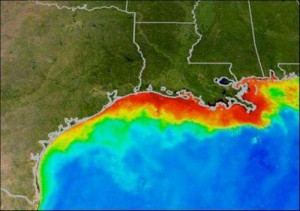
What is the Gulf of Mexico Dead Zone you ask? Well…it’s a layer of hypoxic water (low in dissolved oxygen) on the bottom of the Gulf of Mexico. It was first detected in the 1970’s but reached its peak in size in the 1990’s. The low levels of dissolved oxygen decrease the amount of marine life on the bottom of the Gulf within this zone, including many commercially valuable species supporting the Gulf seafood industry.
What Causes this Dead Zone?
Drops in concentrations of dissolved oxygen within the water column can occur for a variety of reasons but is usually caused by one of two reasons. (1) Increasing water temperatures—as water temperature increases, its ability to hold dissolved oxygen decreases. (2) A process called eutrophication.
What is eutrophication?
Eutrophication is a process where an increase of nutrients in an aquatic system triggers an algal bloom of microscopic phytoplankton. These phytoplankton produce oxygen during the daylight hours but consume it in the evening. Once the bloom dies, decomposing bacteria begin to break them down and consume larger amounts of dissolved oxygen in doing so. When the dissolved oxygen concentrations drop below 2.0 mg/L we say the water is hypoxic and many marine organisms either begin to move out or die. The nutrients that trigger such blooms are primarily nitrates and phosphates. These can be introduced to the water column with plant and animal waste and with synthetically produced fertilizers we use on our fields and lawns. There is natural eutrophication, but when the process is triggered or accelerated by human activity we use the term cultural eutrophication.
So which is it; warming waters or eutrophication?
The Gulf of Mexico Dead Zone usually forms in spring and lasts through September. These are certainly the warmer months of the year, but the warmer waters are near the surface and much of the water column is not warm enough to cause this. Another point is that the Dead Zone is near Louisiana and there are warm locations in other parts of the Gulf where dead zones do not occur. However the Mississippi River does discharge near Louisiana. This river drains 41% of the continental United States, which contains 52% of the nation’s farms. The agricultural waste (plant, animal, and synthetic fertilizers) discharged into the Mississippi River contains nitrogen and phosphorus, the two key nutrients that trigger algal blooms. Based on this, most scientists agree that cultural eutrophication is the primary cause of the Gulf Dead Zone.
When they say it will be a “typical year”, what does that mean – what is a “typical year”?
Scientists from NOAA, the U.S. Geological Survey, and six partnering universities have released their annual forecast of the Dead Zone. The 2015 prediction has the area of the dead zone about equal to the size of Connecticut, which has been the average size for the past several years. This is what they mean by typical.
Can these dead zones occur in our area waters?
Yes, and they do. We do not typically call them “dead zones” but the same process occurs all over the world, including the bays of the Florida panhandle.
What can we do to reduce cultural eutrophication locally?
If you can do without fertilizing your lawn (or field), then do. If this is not an option then only put the amount of fertilizer required for your land/lawn. Most people over fertilize, which not only reduces water quality but is expensive for the property owners. If you can compost your plant waste, do so. With animal waste, please dispose of properly, in a manner where it not reach local waterways.
For more information on hypoxia, eutrophication, and solutions to reduce this problem, contact your county Extension office.
http://www.tulane.edu/~bfleury/envirobio/enviroweb/DeadZone.htm
http://www.iseca.eu/en/science-for-all/what-is-eutrophication
http://earthobservatory.nasa.gov/Features/Phytoplankton/
Posted: July 11, 2015
Category: Disaster Preparation, WORK & LIFE
Tags: Dead, Gulf, Like, Looks, Mexico, Panhandle Outdoors, Typical, Year, Zone


